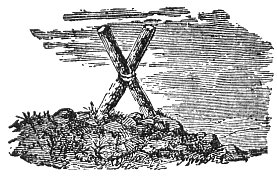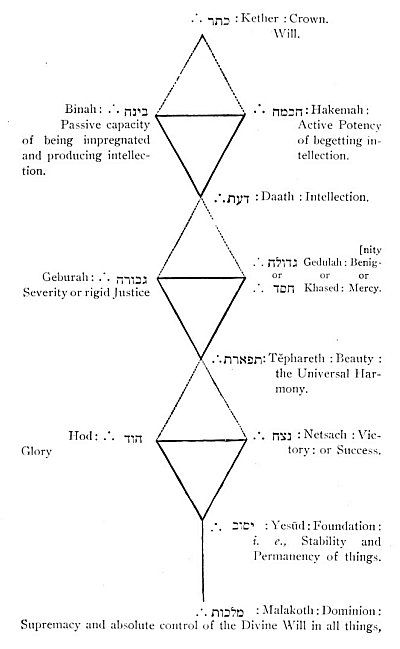“The Templars, or Poor Fellow-Soldiery of the Holy House of the Temple intended to be re-built, took as their models, in the Bible, the Warrior-Masons of Zorobabel, who worked, holding the sword in one hand and the trowel in the other. Therefore it was that the Sword and the Trowel were the insignia of the Templars, who subsequently, as will be seen, concealed themselves under the name of Brethren Masons. [This name, Frères Masons in the French, adopted by way of secret reference to the Builders of the Second Temple, was corrupted in English into Free-Masons, as Pythagore de Crotone was into Peter Gower of Groton in England. Khairu_m or Khu_r-u_m, (a name mis-rendered into Hiram) from an artificer in brass and other metals, became the Chief Builder of the Haikal Kadosh, the Holy House, of the Temple, the Ἱερος Δομος; and the words Bonai and Banaim yet appear in the Masonic Degrees, meaning Builder and Builders.]
“The trowel of the Templars is quadruple, and the triangular plates of it are arranged in the form of a cross, making the Kabalistic pantacle known by the name of the Cross of the East. The Knight of the East, and the Knight of the East and West, have in their titles secret allusions to the Templars of whom they were at first the successors.
“The secret thought of Hugues de Payens, in founding his Order, was not exactly to serve the ambition of the Patriarchs of Constantinople. There existed at that period in the East a Sect of Johannite Christians, who claimed to be the only true Initiates into the real mysteries of the religion of the Saviour. They pretended to know the real history of YESUS the ANOINTED, and, adopting in part the Jewish traditions and the tales of the Talmud, they held that the facts recounted in the Evangels are but allegories, the key of which Saint John gives, in saying that the
p. 817
world might be filled with the books that could be written upon the words and deeds of Jesus Christ; words which, they thought, would be only a ridiculous exaggeration, if he were not speaking of an allegory and a legend, that might be varied and prolonged to infinity.
“The Johannites ascribed to Saint John the foundation of their Secret Church, and the Grand Pontiffs of the Sect assumed the title of Christos, Anointed, or Consecrated, and claimed to have succeeded one another from Saint John by an uninterrupted succession of pontifical powers. He who, at the period of the foundation of the Order of the Temple, claimed these imaginary prerogatives, was named THEOCLET; he knew HUGUES DE PAYENS, he initiated him into the Mysteries and hopes of his pretended church, he seduced him by the notions of Sovereign Priesthood and Supreme royalty, and finally designated him as his successor.
“Thus the Order of Knights of the Temple was at its very origin devoted to the cause of opposition to the tiara of Rome and the crowns of Kings, and the Apostolate of Kabalistic Gnosticism was vested in its chiefs. For Saint John himself was the Father of the Gnostics, and the current translation of his polemic against the heretical of his Sect and the pagans who denied that Christ was the Word, is throughout a misrepresentation, or misunderstanding at least, of the whole Spirit of that Evangel.
“The tendencies and tenets of the Order were enveloped in profound mystery, and it externally professed the most perfect orthodoxy. The Chiefs alone knew the aim of the Order: the Subalterns followed them without distrust.
“To acquire influence and wealth, then to intrigue, and at need to fight, to establish the Johannite or Gnostic and Kabalistic dogma, were the object and means proposed to the initiated Brethren. The Papacy and the rival monarchies, they said to them, are sold and bought in these days, become corrupt, and to-morrow, perhaps, will destroy each other. All that will become the heritage of the Temple: the World will soon come to us for its Sovereigns and Pontiffs. We shall constitute the equilibrium of the Universe, and be rulers over the Masters of the World.
“The Templars, like all other Secret Orders and Associations, had two doctrines, one concealed and reserved for the Masters, which was Johannism; the other public, which was the Roman Catholic. Thus they deceived the adversaries whom they sought

Moe is the founder of GnosticWarrior.com. He is a father, husband, author, martial arts black belt, and an expert in Gnosticism, the occult, and esotericism.






